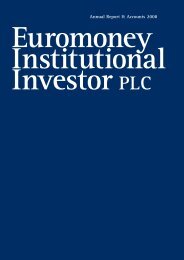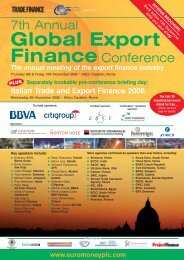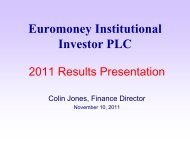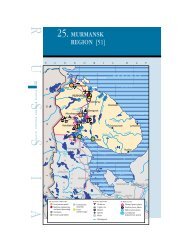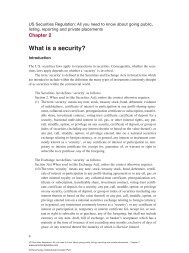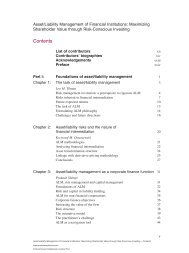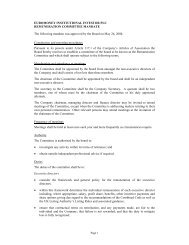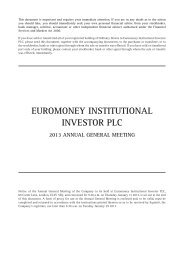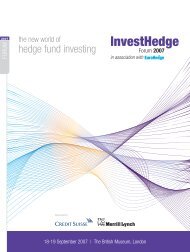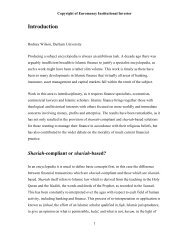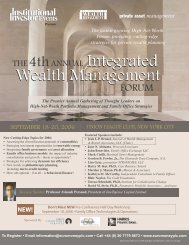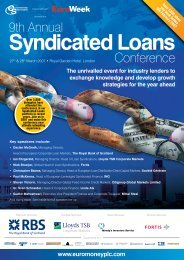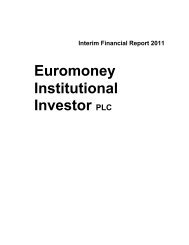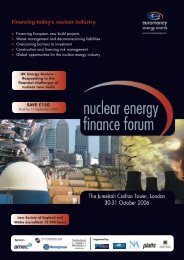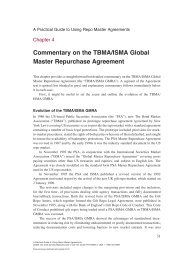something to smile about? - Euromoney Institutional Investor PLC
something to smile about? - Euromoney Institutional Investor PLC
something to smile about? - Euromoney Institutional Investor PLC
You also want an ePaper? Increase the reach of your titles
YUMPU automatically turns print PDFs into web optimized ePapers that Google loves.
LEAD STORYVALUE CREATIONPhilipsRoyal PhilipsElectronics, the thirdlargest global consumerelectronics maker, hasbeen using EVA as aninstrument <strong>to</strong> measurefinancial performancesince 1997.Philips recognizedthat the normal netincome profit and lossaccount didn’t accountfor a company’s cost ofcapital, says groupcontroller GerardRuizendaal. “We wanted<strong>to</strong> make it visible so wecould understand thiscost.” EVA has sincebeen ingrained in thecompany’s standardsand is based on the cos<strong>to</strong>f capital that in eachactivity, reflects the riskrelated <strong>to</strong> the business,geography and effectivetax rates. “The mainidea is <strong>to</strong> improve ourEVA every year so ourreturn of capital is morethan our cost of capital,”says Ruizendaal.One of Ruizendaal’smain responsibilities asgroup controller isperformancemanagement, “lookingat systems, metrics, andhow <strong>to</strong> measure thevalue of our strategies.”Europe’s Kondragunta. “There is a lotmore future growth associated withcompanies with high R&D so naturallythey have a higher MVA.”Value creationAn analysis of investments in the sharesof Stern Stewart’s publicly-owned USclients showed they produced 49% morewealth after five years than equalinvestments in shares of competi<strong>to</strong>rswith similar market capitalisations.Philips measuresvalue creation on astrategic level and forinvestments throughnet present valuetechniques, saysRuizendaal. At theoperating level, valuecreation is measured viaEVA. “With EVA youdon’t look <strong>to</strong> short-termmovements in shareprices, but <strong>to</strong>consistently improvingthe returns above thecost of capital.”EVA is not theexclusive measurement<strong>to</strong>ol at Philips. Thecompany also uses thebusiness balancescorecard. Ruizendaalexplains: “Currentfinancial performance isessentially aconsequence of whatyou have achieved inthe past in the business,so we try <strong>to</strong> correlatethis financialperformance withleading non-financialdrivers such ascus<strong>to</strong>mer satisfactionbased measurementsand process basedmeasurements.” (eg, onsupply chainperformance).“All the decisionmaking <strong>to</strong>ols must beconsistent for drivingvalue creation withinthe company, and withevery year, with everyprocess, it becomes away of life.Philips also looks athow <strong>to</strong> integrate EVAin<strong>to</strong> its staff incentivestructure, with EVAaccounting forapproximately 50% ofthe criteria for yearlybonus incentives. “Theamount of share optionsoffered <strong>to</strong> employeesdepends on the shareperformance versus 24benchmarkedcompanies, and theincentives are less if wedon’t outperformagainst our benchmarkpeers.”Over the last twoyears, Philips hassystematically changedits portfolios <strong>to</strong>businesses with returnof capital greater thanthe cost of capital.Gerard Kleisterlee,president, emphasizedthis in his message inthe company’s 2003annual report, saying,that over the past yearPhilips had madeconsiderable progresson its journey <strong>to</strong> createOne Philips - a single,focused and clearlyidentifiable companygeared <strong>to</strong> sustainedvalue creation.How?As a company you are committed <strong>to</strong>shareholder value creation. But do youunderstand where and how value isbeing created and whereopportunities for value creation lie?MVA, EVA and value-based managementcompanies do, saysKondragunta, and that is why those UScompanies produce 49% wealth.Managers, and this essentiallymeans the CFO, at value-based managementcompanies believe that thereare only three basic ways <strong>to</strong> increaseand manage value. The first is <strong>to</strong>increase the returns from the assetsalready in the business by running theincome statement more efficientlywithout investing new capital. The secondis <strong>to</strong> invest additional capital andaggressively build the business so longas expected returns on new investmentsexceed the cost of capital. Andthe third is <strong>to</strong> release capital from existingoperations, both by selling assetsthat are worth more <strong>to</strong> others and byincreasing the efficiency of capital bysuch measures as turning working capitalfaster and speeding up cycle times.Total and Exxon do not subscribe <strong>to</strong>value-based management, but bothfirmly believe that the culture, strategyand financial controls of value-basedmanagement are firmly in place attheir companies.“We have a global functional organisationoperationally consistentthroughout. It is this consistentapproach that embraces the core principlesat Exxon,” says Mulva.Exxon subscribes <strong>to</strong> a high returnand low risk strategy, “not overcapitalisingon investment [but] being focusedon the long-term,” says Mulva. It is anapproach that has steered the companythroughout its his<strong>to</strong>ry, and enabled it <strong>to</strong>outperform its competi<strong>to</strong>rs over thepast 20 years. So how does Exxonmeasure the value its core principlesbring? Through return on capitalemployed (ROCE - income before financialitems relative <strong>to</strong> average capitalemployed). “Shareholders entrust uswith their capital and we tell them howwell we have managed it throughROCE. People understand ROCE. It is avery powerful,” says Mulva.It is a similar tale at Total. “We runthe company from an industrial viewpoint.We allocate cash in an efficientmanner and measure through returnon average capital employed.” (ROACE- operating profit before amortizationof goodwill x 100/ average invested capital,accumulated amortization ofgoodwill). “It is a consistent measure ofshareholder value in our industry andallows our inves<strong>to</strong>rs <strong>to</strong> compare likewith like.” In its 2003 report, Total26 cf March 2004 corporatefinancemag.com



